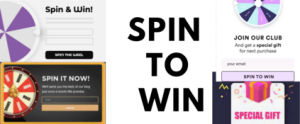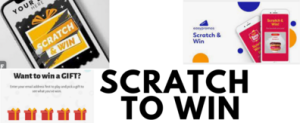Studies have shown that there is a 30% increase in customer engagement when game elements are incorporated.
Another case study by a major cosmetics brand that supports this claim revealed a 40% surge in sales after implementing a gamified loyalty program.
A popular app that utilized this gamification power is Duolingo. They replaced a standard signup form with a fun emoji memory challenge. This doubled their email signups and increased their engagement by 48%.
Now the above statistics and experiment prove that gamification isn’t just fancy graphics but a potential tool for marketers to use and transform customer interactions and elevate business success.
READ NOW: 10 Exceptional Strategies to Boost Customer Engagement With Popups Optimization
Unlike static popups, interactive popups offer a dynamic way to capture user attention, encourage active participation and improve user experience.
Interactive popups include games that let you unlock secret levels with every purchase, quizzes that let you ‘fish’ for discounts, and surveys that let you answer trivia for freebies.
These playful popups make buying fun, grab attention, and most importantly, boost engagement like crazy!
In essence, Gamified popups as a powerful tool for boosting engagement and sales will be discussed further in this article.
The Psychology of Gamification
Gamification cleverly exploits psychological drivers, turning mundane activities into engaging experiences. Below are some of the psychological principles behind gamification:
- Intrinsic motivation and the desire for rewards.
- Competition and the drive to win.
- Progress and the joy of achieving goals.
- Playfulness and the escape from the mundane.
- The element of surprise.
Intrinsic motivation and the desire for rewards
When users play games, the immediate feedback in the form of rewards exploits the brain’s pleasure center, reinforcing desired behaviors. There’s then no need to push them further cause they’re already motivated.
Reward, to the user, is like a pat in the back. Every click, purchase, or scroll earns the user a reward. The reward could be badges, unlocking secrets, progress bars, leveling up, points, or even beating their own score.
It fuels their drive and keeps them going.
Competition and the drive to win
Gamification triggers in users the need for connection and friendly competition, fostering a community spirit.
Leaderboards, and challenges light a fire under the user, making even the most mundane tasks feel like a race to the top.
Interactive popups like ‘Scratch to win!’, ‘Spin to win!’, or ‘Challenge your friends in our trivia quiz!’ tap into the user’s natural drive to outperform and channel that competitive spirit.
Most times, it’s not really about the prize, but about the bragging rights and the sweet taste of victory.
DID YOU KNOW? There are 7 Underrated Strategies to Skyrocket Conversions in 2024
Progress and the joy of achieving goals
Interactive popups utilize this principle by incorporating elements like progress bars, achievements, and personalized milestones to harness the psychological joy of progress and goal achievement.
Interactive popups use this, like ‘Spin to Win!’ or ‘Scratch to Win!’
Each spin, click, scratch, or point earned feels like progress, and fuels the user’s desire to see what is beneath the surface right before they scratch, or to see the wheel spin again.
Playfulness and the escape from the mundane
Gamification turns boring tasks into delightful adventures. It makes learning and progress way more enjoyable.
These playful escapes from the usual website routine break the monotony, spark curiosity, and turn engagement into an exciting adventure.
Users interact, explore and click, not just because they want the prize, but simply because they enjoy the playful break.
The element of mystery and surprise
This is quite common in games, and it sustains interest and curiosity. The unexpected rewards and unlockable levels is what piques the user’s curiosity and keeps him/her engaged.

Never knowing what fun awaits next intrigues the users and keeps them interested.
Interactive popups tap into our curiosity, like a game with hidden treasures unveiling new surprises and rewards the user didn’t expect.
How can interactive popups leverage these principles to engage users?
Interactive popups tap into the user’s inner child like no regular popup can. They manipulate the user’s mind, using sneaky psychological tricks to boost engagement.
They do this through various ways. One, is making the user feel a sense of achievement by giving them badges, points, and progress bars when they win.
Secondly, is by piquing their curiosity through surprise rewards, hidden levels, and mystery wheels. Thirdly, is by unleashing their competitive streak through challenges and leaderboards.
The final means is by giving them a break from website routine to play interactive games like product puzzles and quizzes.
Interactive Popups in Action
Below are creative examples of gamified popups across different industries:
Spin-to-win

Spin-to-win can be remarkably effective for boosting engagement due to its visual appeal. The appeal has a fun and dynamic aspect that captures attention and encourages participation.
Aside from visual appeal, it also has the element of chance. The element of chance fosters a feeling of unpredictability which keeps users engaged for longer periods.
The results gotten by utilizing Spin-to-win is determined through the following ways:
- Increased Click-through rates
- Multiplied leads and conversions
- Makes the brand more memorable.
- Skyrockets dwell time by 30% or more.
Scratch-to-Win

Scratch-to-win entices users by giving them the thrill of scratching virtual cards to unveil potential prizes, creating a sense of suspense. This makes users spend more time on the platform seeking rewards.
Users hang around, eagerly scratching away, hoping to reveal a big win. The anticipation and excitement of uncovering a prize, even a small discount, can lead to action.
Its effectiveness can also be determined through the means listed under Spin-to-win above.
CHECK OUT NOW! 5 Advanced Popup Triggers Ecommerce Stores are Missing Out On
Interactive quizzes/contests or product recommendations
Some users are usually drawn in by the challenge and opportunity to showcase their knowledge or skills.
Instant feedback and real-time scoring provide a sense of achievement, motivating users to continue and share their results.
These popups are engagement powerhouses that drives metrics up. The promise of testing their knowledge or winning a prize turns the users’ heads.
Progress bars
Progress bars turn boring tasks into mini-adventures with a finish line in sight. The transparency of progress creates a sense of accomplishment, motivating users to continue and complete tasks.
Users see their progress visualized, fueling them to click, explore, and complete that email signups, loyalty programs, or purchase. The visual cue minimizes uncertainty, reducing frustration and increasing user satisfaction.
Designing Effective Gamified Popups
We will now be giving our readers practical tips for creating gamified popups that convert:
- Align the game with your brand and target audience
- Keep it simple and user-friendly
- Offer relevant and appealing rewards
- Use clear visuals and engaging language
- Utilize the element of surprise
- Set Clear rules and time limits
- A/B test different elements to optimize performance
- Call-to-action, clear and bright
- Monitor and measure
Align the game with your brand and target audience
Your game should not be generic; that is, it should not be targeted to all customers. It should align with your brand to ensure relevance. As an e-commerce owner, you should know your audience.
Choose a game mechanic that aligns with their interests and age.
Keep it simple and user-friendly
Instead of using complex rules or lengthy instructions, e-commerce owners should use fast clicks, mobile friendliness, and instant gratification.
Offer relevant and appealing rewards
Let your rewards be irresistible to your audience. For instance, you could give a free sock to someone that purchases a shoe.
Tailor them to your customers and value proposition.
Use clear visuals and engaging language
Your visuals should not be dull, but colourful and inviting. The colours should be bright, the animations playful, and the graphics clear.
Clear visuals should also incorporate a user-friendly interface with easy navigation.
Utilize the element of surprise
Mystery elements and unexpected rewards keep users engaged and coming back for more. Hence, e-commerce owners should use elements such as lucky dip prizes or hidden levels.
Set Clear rules and time limits
E-commerce owners should not leave their users to make their own rules, it could be chaotic. Setting rules and time limits will create a sense of urgency and increase the user’s excitement.
A/B test different elements to optimize performance
Here, data is a friend and should be used to optimize performance. E-commerce owners should try different mechanics, designs, and prizes to see what resonates most or works best for them.
Call-to-action, clear and bright
E-commerce owners should try as much as possible not to leave their users in a state of confusion. Always tell users what they should do next – whether it’s signing up, purchasing, or simply playing again.
Monitor and measure
Don’t just put up a popup and disappear. Track clicks, engagement metrics, and conversions. Study what works, what doesn’t, and iterate your game.
Beyond Engagement: Driving Sales With Gamification
Listed below, are ways through which gamified popups can boost sales:
- Encouraging purchases with limited-time offers or gamified discounts.
- Educating and motivating customers with interactive product demos
- Rewarding loyalty and driving repeat purchases through gamified points systems
To End With,
The benefits of using gamified popups for engagement and sales cannot be overemphasized. If used properly, it can boost click-through rates (CTRs), skyrocket leads and conversions, and increase brand recall.
Hence, e-commerce owners should ensure to experiment with their own gamified campaigns.
Also Read
5 Advanced Popup Triggers Ecommerce Stores are Missing Out On
7 Underrated Strategies to Skyrocket Conversions
10 Exceptional Strategies to Boost Customer Engagement With Popups Optimization
Popups for Lead Generation: Capturing Emails and Building Ecommerce Lists
The Secret Tool to Sell More Custom T-Shirts on Your Ecommerce Website

